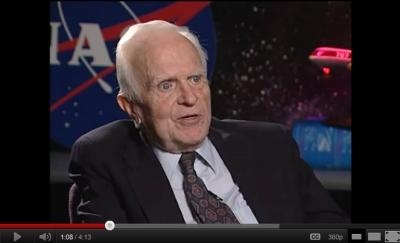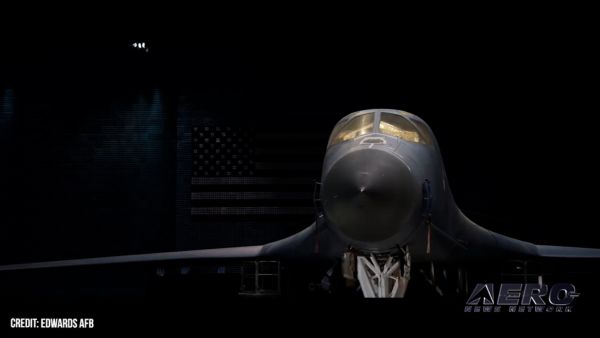Richard Whitcomb Will Be Installed Posthumously For His
Accomplishments
Aeronautics engineer Richard T. Whitcomb, whose research
contributions at NASA's Langley Research Center made supersonic
flight practical, will soon join other aerospace pioneers in the
National Aviation Hall of Fame, located at the National Museum of
the United States Air Force in Dayton, Ohio.
NASA TV Y ouTube Image

The National Aviation Hall of Fame just announced Whitcomb
(pictured), who died in 2009 at age 88, is among the 2012 honorees.
Also included are well-known aviation artist Keith Ferris;
Geraldine Cobb – a female aviation pioneer who also trained
as an astronaut in the 1960s; and the late Elwood Quesada - an Air
Force general and pilot who in 1929 helped develop and demonstrate
air to air refueling and was the first commander of the USAF
Tactical Air Command and first head of the Federal Aviation
Administration.
The National Aviation Hall of Fame is dedicated to honoring
individuals who have uniquely contributed to America's rich legacy
of aviation achievement, according to its website. Since 1962 it
has inducted more than 200 of the nation's premier air and space
pioneers into the organization, including the Wright Brothers,
Amelia Earhart, Charles Lindbergh and astronauts John Glenn, Neil
Armstrong and others.
Richard Whitcomb may not be as much of a household name as
others, but aviation historians say his role in aeronautics
research is virtually unmatched. "Dick Whitcomb's intellectual
fingerprints are on virtually every commercial aircraft flying
today," said Tom Crouch, noted aviation historian at the
Smithsonian Institution. Whitcomb spent his career at what is now
NASA's Langley Research Center in Hampton, VA. Born in Evanston,
Ill., in 1921, he graduated from Worcester Polytechnic Institute in
Massachusetts in 1943. After college he joined the Transonic
Aerodynamics Branch of NASA's predecessor, the National Advisory
Committee for Aeronautics (NACA), at Langley Memorial Aeronautical
Laboratory. Whitcomb retired from the Hampton facility in 1980.
Relatively early in his career, in 1952, the aeronautics
engineer discovered and experimentally verified a revolutionary
aircraft design principle that became known as the area rule.
Whitcomb discovered if he narrowed the fuselage of an airplane so
it's shaped more like an old-fashioned soda bottle, he could reduce
drag and increase the speed of a transonic aircraft without the
need to add additional power. The area rule has been applied
to almost every U.S. supersonic aircraft designed since then. The
achievement earned him the prestigious 1954 Collier Trophy for the
most important aeronautical advance of the year.
If the area rule was Whitcomb's major accomplishment of the
1950s, his supercritical wing revolutionized the design of jet
liners in the 1960s. The key was the development of a swept-back
wing airfoil that delayed the onset of increased drag, increasing
the fuel efficiency of aircraft flying close to the speed of
sound.

In the 1970s Whitcomb came up with winglets, wingtip devices
that reduce yet another type of drag and further improve
aerodynamic efficiency. Many airliners and private jets currently
sport wingtips that are angled up for better fuel performance.
In addition to his induction into the National Aviation Hall of
Fame and the Collier Trophy Whitcomb was presented the National
Medal of Science by President Richard Nixon in 1973 and received
the U.S. Air Force Exceptional Service medal in 1955, the first
NACA Distinguished Service Medal in 1956, the NASA Exceptional
Scientific Achievement Medal in 1959 and the National Aeronautics
Association's Wright Brothers Memorial Trophy in 1974. The engineer
was also inducted into the National Inventors' Hall of Fame in
2003, the National Academy of Engineering in 1976 for his
pioneering research in the aerodynamic design of high performance
aircraft and the Paul E. Garber First Flight Shrine at the Wright
Brothers National Memorial in North Carolina. Whitcomb's alma
mater, Worcester Polytechnic Institute, also awarded him an
honorary doctorate and its presidential medal.
 ANN's Daily Aero-Term (09.17.24): Instrument Approach Procedure (IAP) Charts
ANN's Daily Aero-Term (09.17.24): Instrument Approach Procedure (IAP) Charts Aero-News: Quote of the Day (09.17.24)
Aero-News: Quote of the Day (09.17.24) Airborne 09.16.24: Bristell Shooting, EAA v FAA, Boeing Strike!
Airborne 09.16.24: Bristell Shooting, EAA v FAA, Boeing Strike! Classic Aero-TV: CubCrafters NX Cub-A Stunning Effort To Build The Perfect Cub'
Classic Aero-TV: CubCrafters NX Cub-A Stunning Effort To Build The Perfect Cub' Airborne 09.18.24: Boom XB-1 3rd Test, DJI Ban, SubSonex To EAA Museum
Airborne 09.18.24: Boom XB-1 3rd Test, DJI Ban, SubSonex To EAA Museum




